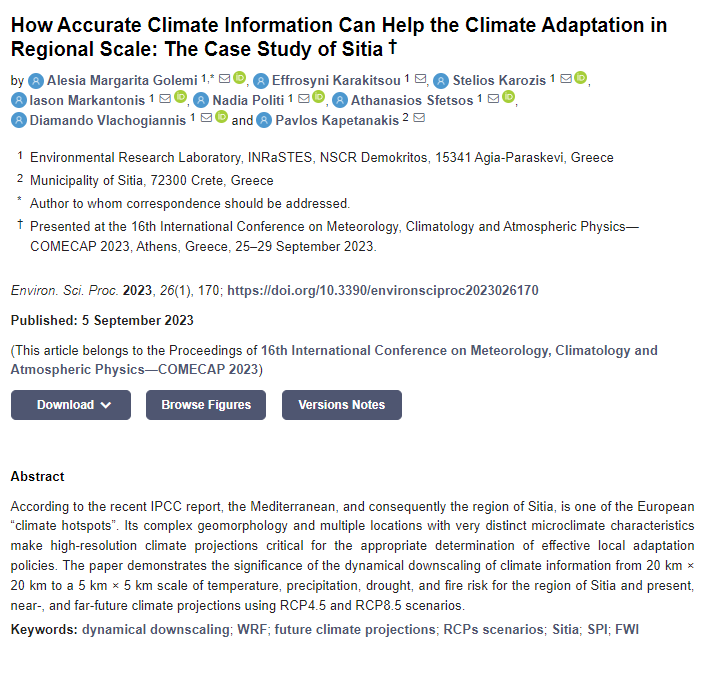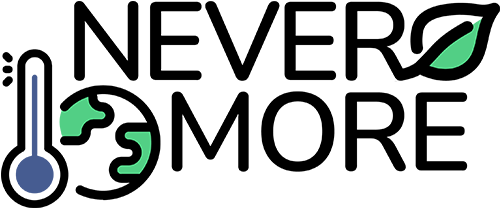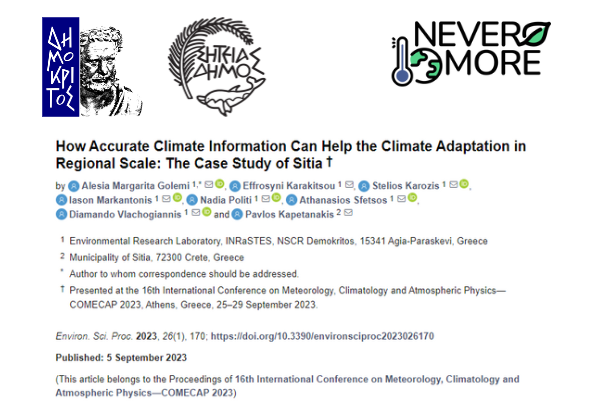The convergence of research, innovation and community engagement is essential in the quest for a sustainable and resilient future. The publication of the proceedings paper entitled “How Accurate Climate Information Can Help the Climate Adaptation in Regional Scale: The Case Study of Sitia”, published by MDPI, represents a significant analysis of a climate change hotspot in the ongoing NEVERMORE project. The paper will be presented at the 16th International Conference on Meteorology, Climatology and Atmospheric Physics – COMECAP 2023, Athens, Greece, 25-29 September. The research focuses on the climatic challenges faced by the municipality of Sitia in Crete, Greece (one of the 5 case studies of the NEVERMORE project).
Understanding Sitia’s Unique Climate Challenges
Situated in the Mediterranean, Sitia has been thrust into the spotlight by the alarming climate trends highlighted by the Intergovernmental Panel on Climate Change (IPCC). As one of Europe’s ‘climate hotspots’, Sitia’s complex geomorphology and microclimatic diversity make it a compelling case study. Its dependence on the climate-agriculture-water-biodiversity-tourism nexus places it at the forefront of climate adaptation concerns.
The NEVERMORE project has embarked on a journey to empower stakeholders, decision-makers and the local community through a collaborative modelling approach. Sitia’s complex terrain and vulnerability underscore the need for high-resolution climate data and science-based decision making. The publication of this paper serves as a cornerstone in this endeavour, providing a deep dive into the region’s climate complexities.
One of the key findings of this research revolves around the need for high resolution climate data in Sitia. The paper presents a comprehensive analysis of temperature and rainfall patterns. It highlights the intricate variations across Sitia’s terrain, showing how microclimates can vary significantly even within a relatively small region. These findings are crucial for identifying areas of tourism and agriculture that are likely to face increased risks such as floods, severe droughts and forest fire.
The research introduces two critical climate indices: the Standardized Precipitation Index (SPI) and the Fire Weather Index (FWI). These indices, projected under different emission scenarios (RCP4.5 and RCP8.5), reveal the evolving nature of droughts and fire risks in the region. Notably, the research showcases that Sitia’s eastern coast, home to the Municipality’s capital, is particularly vulnerable to these climate extremes.
Beyond the scientific revelations, the NEVERMORE project places great emphasis on stakeholder engagement. The paper’s findings are not confined to academic circles but are actively shared with the local community and decision-makers. This participatory approach allows for a more profound understanding of Sitia’s unique climate challenges and fosters a collaborative environment for crafting resilience-building policies.
Sitia’s complex climate landscape demands high-resolution data and science-based adaptation strategies, and this paper provides a crucial foundation for these endeavors within the NEVERMORE framework. By analysing the region’s climate intricacies, the research empowers stakeholders and local communities to navigate the challenges posed by climate change with greater confidence and resilience.

Link to the Paper: Read the full paper here
Link to the COMECAP 2023 Conference: More information about the conference

